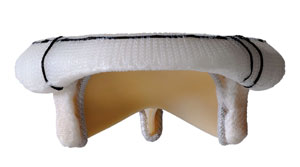Valve features advancements to clinically-proven design
The changes allow easier replacement of diseased valves in younger populations.
Click Here to Manage Email Alerts
A new valve designed to enhance implantation in the challenging mitral position was officially launched in September at the 24th Annual Meeting of the European Association for Cardio-Thoracic Surgery in Geneva.
The new valve (Perimount Magna Mitral Ease, Carpentier-Edwards) is a pericardial tissue-based bioprosthetic device for patients requiring replacement of diseased mitral heart valves. It facilitates access, placement and suturing during conventional and minimally invasive heart valve surgeries, particularly those utilizing a thoracotomy.
The Magna Mitral Ease has been developed for easier implantation through design enhancements, such as a tri-colored holder; a unique suture guide line; and a wide, saddle-shaped cuff. The device’s ease of use is something Patrick M. McCarthy, MD, chief of the division of cardiac surgery and director of the Bluhm Cardiovascular Institute, Northwestern Memorial Hospital, Chicago, has experienced firsthand.
|
Source: Edwards Lifesciences |
“I’ve been using the pericardial mitral valve for roughly 18 years. When they started to develop the Magna Mitral Ease, I immediately liked its design,” McCarthy told Cardiology Today. “This device makes it a little easier and more user-friendly for surgeons to implant the mitral valve, which can sometimes be a challenge.”
For Kevin D. Accola, MD, thoracic and cardiovascular surgery, Florida Hospital Cardiovascular Institute in Orlando, one of the highlights of utilizing new technologies with bioprosthetic tissue fixation processes has been the ability to perform bioprosthetic valvular surgery on younger patients, which had previously been limited to those 70 years and older because of the valves’ once short lifespan.
“Now, these new valves, in particular the Magna Mitral Ease, provide a younger person — aged 55 to 60 years — the opportunity to have replacement with a bioprosthetic valve rather than a mechanical valve, which requires life-long anticoagulation therapy,” Accola told Cardiology Today. “This particular valve, with the ThermaFix Advanced Heart Valve Tissue Process, provides an opportunity to be the patient’s only valve replacement.”
According to Accola, Edwards Lifesciences currently has 20- to 25-year data that substantiates the durability and freedom of structural valve deterioration with the current designs and tissue fixation processes, which delays the necessity for replacement.
“This provides assurance to younger patients, who may require valve replacement because mitral valve repair is not an option; this allows them to avoid life-long anticoagulation with warfarin (Coumadin, Bristol-Myers Squibb),” he said. “One of the advantages of the new Mitral Magna Ease valve is that it has a low-profile valve design, which because of its unique sewing ring, conforms and recreates a more normal anatomic annular profile.”
“The valve will be good for surgeons and, therefore, patients because it will take what can be a difficult operation and make it a little easier,” McCarthy said. “This will translate into a quicker operation for the patient and hopefully, therefore, a quicker recovery.” – by Brian Ellis
Editor’s Note: McCarthy reports that he invented three Edwards Lifesciences valve repair products and works as a consultant for educational issues on how to perform valve repair. Accola provides consultant services for Edwards Lifesciences and serves on its speakers’ bureau.

